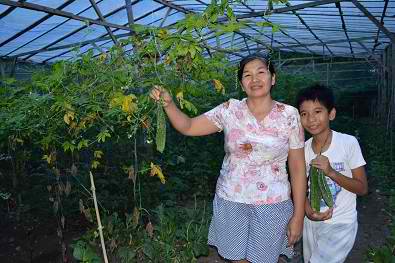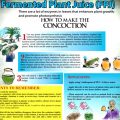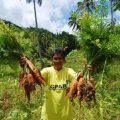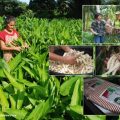Farming equates income, especially to a common farmer. Aside from providing food on the table, farmers cultivate the land to earn money. Sadly though, it is not always the case for our local farmers especially when it comes to organic farming.

Farmers have this notion that organic farming is not as profitable compared to traditional farming. “Mahal, matagal ang kita,” would be their usual response when asked about organic farming. But Ifugao farmers proved this wrong as they many of them have thrived going into organic farming.
It all started with CPAR
When the Community-based Participatory Action Research (CPAR) on organic vegetable production project was introduced, through the efforts of Dr. Catherine Buenaventura of the Provincial Agriculture Environment and Natural Resources Office (PAENRO), farmers from Kiangan, Ifugao, conceived a whole new perspective of organic agriculture.
The Ifugao province is known for its favorable microclimate parameters conducive to farming vegetables. In fact, Ifugao is among Cordillera Administrative Region’s (CAR) provinces — along with Benguet and the Mountain Province — tagged as the “Salad Bowl” of the Philippines, supplying about 80 percent of the vegetable market in the country. In the case of Ifugao province, the most common vegetables grown are snap beans, string beans, pechay, Chinese cabbage, eggplant, and tomato.
However farmers were accustomed to the traditional way of farming, which makes use of chemicals inputs as means to manage weeds and pests. This practice led to different issues such as high cost of inputs, and depleting soil health. It is the very same reason why the CPAR team thought of introducing organic agriculture in the province.
Specifically, the project aims to increase the income of selected farmers through the adoption of organic vegetable production techniques, reduce cost of farm inputs, improve farmers’ capability in organic farming, and improve the resource management capacities of rural communities within the province.
Forty farmers from barangays Banguine and Tuplac were chosen to participate in the project. To fully prepare them, two organizational development workshops were provided which resulted to the organization of the Baguinge Organic Farmers’ Association (BOFA) and the Good Shepherd Organic Farmers Association (GOFA) in 2012. Further, cross farm visits to organic farms of the La Trinidad Organic Producers (LaTOP) in Benguet were conducted so that the CPAR cooperators will experience firsthand exposure to organic agriculture practices.
Following the various trainings and farm visits, the 40 farmer cooperators established their greenhouses in a 100 m2 area. Each was provided inputs, including vinyl plastics and various vegetable seeds. Two shredders were given to each of the association in support to the production of organic fertilizers.
Interventions learned and adopted eagerly by the farmers included land preparation activities which consist of decomposing indigenous microorganisms, application of organic fertilizers into the soil prior to planting, and basal application of organic fertilizers.
During the cropping cycles, certain practices were employed to improve soil fertility especially for farms worn-out of soil nutrients as a result of mono-cropping and excessive application of inorganic fertilizers. Farmers were introduced to crop rotation practices. The cropping pattern includes the rotation of leafy vegetables, ampalaya, eggplant, and crucifers with legumes like snap beans and string beans.
Also introduced during the project was the use of fermented plant juice (extracted from locally available plants like sweet potato, malunggay, and kangkong), fermented fruit juice (extracted from fruits in season like avocado, banana, papaya, and guava), and indigenous microorganisms to improve soil fertility. Mulching was also encouraged especially during the dry season. It was done by spreading over the roots of plants a layer of straw, grass cuttings, leaves, or compost to conserve soil moisture.
On pest control and management, various techniques were used to prevent and control the attack of insect pests and diseases on their plants. They used odorous and bitter materials as repellants. They were taught to formulate botanical pesticides and fungicides using the available indigenous plants in the area.
Such practices reaped good results for the farmers, from the shelf life, to taste and size, they have noticed significant differences. Ernesto Dulnuan, BOFA president, noticed a difference in his organic pechay. “The shelf life of pechay grown the organic way is two days while that grown conventionally is only a day,” he shared. Another farmer cooperator Agapita Kimayong, observed a change in her produce as well in terms of size. “Pechay grown under the vinyl cellophane shed is bigger and grows faster compared to that exposed or without a vinyl cellophane shed,” she said.
The quest for healthier, safer food set this project in motion. Market was never a problem for the farmers’ produce. In fact, Ms. Nene Pahiwon, shared how her organic lettuce is sold fast within her community alone. “I don’t need to go to the market to sell my vegetables. Dito pa lang sa amin, ubos na agad,” she said. But for a sustainable market mechanism, a display center for organic vegetables was put up at the area near the Provincial Capitol of Lagawe. A regular market day is set every Wednesday.
Going beyond CPAR
Farmer cooperator, Aquilina Saguilot used to be a fulltime employee. She was the university librarian at the Ifugao State University. Farming served as a hobby for her until she got involved in the CPAR project on organic vegetable production. The knowledge that she acquired through various trainings she attended enabled her to seek opportunities beyond farming. She put up her own organic farm which she turned into a learning site for farmers and students as well.
Now, the Aquilina Saguilot Farm welcomes farmers, researchers, students, and other private individuals who might be interested to learn and venture into organic farming. Her farm stations included various vegetables such as tomato, mustard, pechay, and bell pepper. Whenever visitors come, she would gladly share all of her learnings she gained from the CPAR project.
The CPAR in Ifugao, particularly in Kiangan and Lamut, has been expanding through the increase in the number of farmer adopters. Apparently, Ms. Saguilot is not the only one who converted her farm into organic farming and learning site. Organic integrated farming is slowly gaining ground in other municipalities. ### (Daryl Lou A. Battad)






